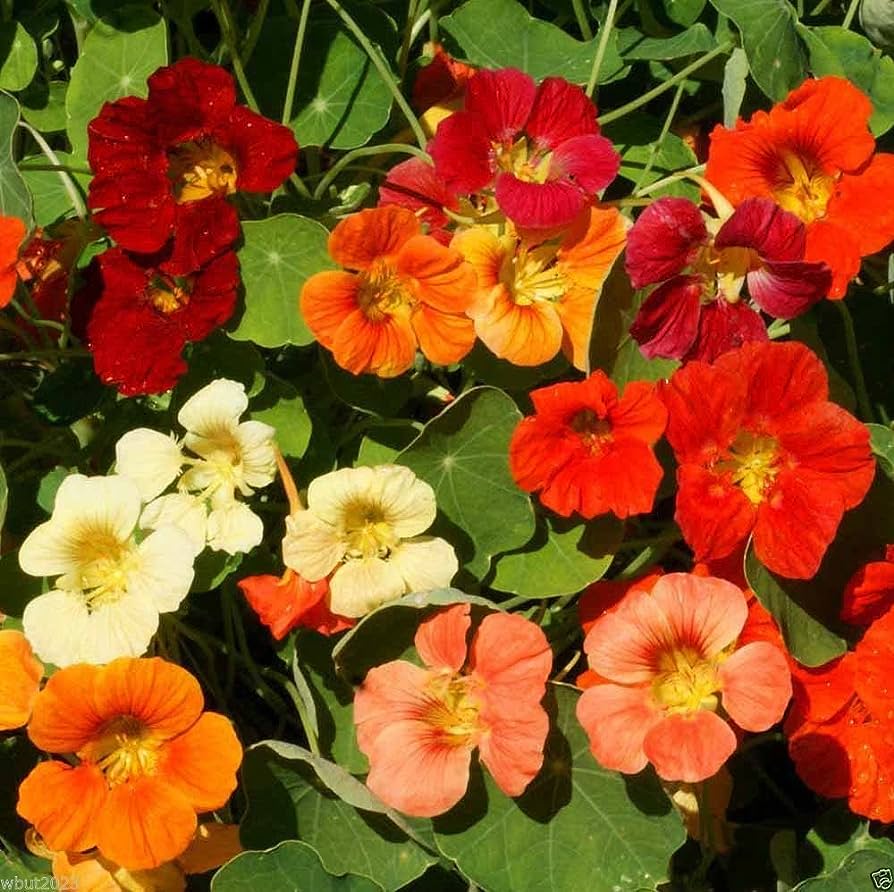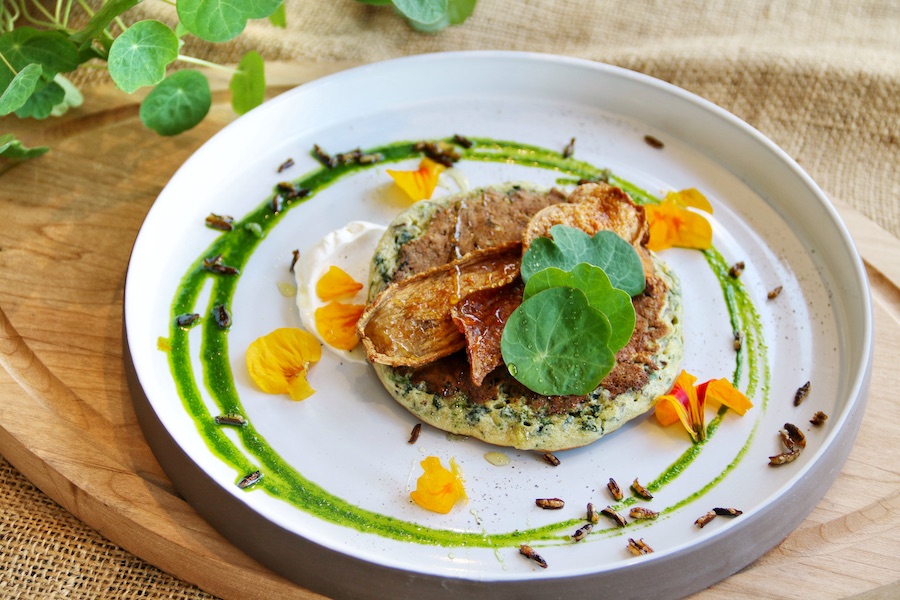Nasturtiums, often referred to as the “jewels of the garden,” are a favorite among many gardeners. Their vibrant nasturtium flowers and variegated foliage make them a standout in any sunny garden. Beyond their beauty, these plants serve a dual purpose: they’re both aesthetically pleasing and offer edible flowers with a unique peppery taste.
| Aspect | Details |
|---|---|
| Common Name | Nasturtium |
| Scientific Name | Tropaeolum majus (for trailing or climbing types), Tropaeolum minus (for bush types) |
| Type | Typically grown as annuals; may perennialize in frost-free zones |
| Sunlight | Prefers full sun but can tolerate partial shade |
| Soil | Thrives in poor, well-draining soil |
| Watering | Regular watering; drought tolerant |
| Planting Location | Garden beds, containers, hanging baskets |
| Days to Harvest | Approximately 50-65 days after planting (this is an estimate; exact days can vary based on variety and growing conditions) |
| Companion Planting | Beneficial for many vegetables; avoid planting near brassicas like broccoli, cabbage, and cauliflower |
| Edible Parts | Flowers, leaves, and immature green seed pods |
| Taste | Peppery, almost mustard-like flavor |
| Maintenance | Deadheading recommended for prolonged blooming |
Types of Nasturtiums
Nasturtiums come in a variety of shapes and sizes. Here’s a breakdown:
Bushy Varieties: Compact and perfect for smaller gardens or window boxes.
Climbing Nasturtium Varieties: Ideal for trellises or fences, they can grow several feet in length.
Trailing Nasturtiums: These are perfect for hanging baskets, adding a cascade of color to patios and balconies.
Table: Popular Nasturtium Varieties
| Variety Name | Type | Color | Special Features |
|---|---|---|---|
| Peach Melba | Bushy | Soft peach with a deep throat | Compact growth |
| Black Velvet | Climbing | Deep red, almost black | Vibrant contrast |
| Canary Creeper | Trailing | Bright yellow | Feather-like leaves |
Planting Nasturtiums
Planting nasturtiums is a straightforward process, but there are some key steps and tips to ensure success:
Timing: Wait until the risk of spring frost has passed. Check the local spring frost date for guidance.
Seeds: Soaking seeds for about a week can expedite germination. Plant them about 10-12 inches apart to give each plant ample space.
Location: Choose a spot in your garden that receives full sun to partial shade. Nasturtiums in containers, especially with drainage holes, can be a delightful addition to patios.
Soil: While they can grow in poor soil, ensuring the soil is moist but well-draining is crucial. If planting in containers, ensure they have adequate drainage holes.
Tips for Successful Planting:
Consider growing nasturtiums alongside other plants in a vegetable garden. They not only add color but also deter certain pests.
If starting seeds indoors, transplant them outdoors once the risk of frost has passed to reduce transplant shock.
For those in warmer climates, consider planting in the late spring to ensure blooms throughout the summer.
Caring for Nasturtiums
Nurturing nasturtium plants is relatively simple, but a few key practices can ensure a thriving garden display:
Watering: While nasturtiums are drought tolerant, they thrive best with consistent moisture. Water them weekly, ensuring the soil remains moist but not waterlogged. During particularly hot periods, check the soil more frequently.
Temperature: Nasturtiums prefer daytime temperatures in the 70s F. They can survive a light frost, but it’s best to protect them if a heavy frost is predicted.
Maintenance: Regular deadheading can prolong blooming and produce more flowers. Simply pinch off faded blooms to encourage new ones.
Fertilizing Nasturtiums
Interestingly, when it comes to nasturtiums, less is more:
Soil Quality: Nasturtiums grow best in poor soil. If the soil is too rich or overly fertilized, you’ll get more foliage than flowers. This unique trait makes them ideal for areas of the garden where other plants might struggle.
Natural Growth: It’s best to let nasturtiums grow naturally without additional fertilizers. If you must fertilize, opt for a balanced, slow-release type and use sparingly.
Propagation and Growth
From seeds to full-grown plants, here’s how to propagate nasturtiums:
Starting from Seeds: Direct sowing after the last frost is the most common method. However, for a head start, seeds can be started indoors 4-6 weeks before the last expected frost.
Planting Depth: Plant nasturtium seeds about ½ inch deep in the soil.
Spacing: Give each plant ample space to grow. Space seeds or transplants about 10-12 inches apart.
Germination: With the right conditions, nasturtium seeds will germinate in 7-10 days.
Culinary Uses of Nasturtiums
Nasturtiums aren’t just for show; they’re a treat for the palate too:
Edible Parts: Both the vibrant nasturtium flowers and the leaves are edible. They have a peppery flavor, similar to arugula or watercress.
Cooking with Nasturtiums: The flowers can be used as garnishes, tossed in salads, or even stuffed with fillings like cream cheese. The leaves add a spicy touch to salads and sandwiches.
Pickling Seed Pods: The immature green seed pods of nasturtiums can be pickled and are known as “poor man’s capers.” They’re a delightful addition to dishes that benefit from a tangy, peppery kick.
Pest Management and Companion Planting
Nasturtiums are both a boon and a magnet in the garden:
Natural Deterrent: When planted alongside vegetables in a garden, nasturtiums can deter pests like aphids and whiteflies. Their strong scent masks the aroma of other plants, keeping pests at bay.
Trap Cropping: On the flip side, nasturtiums can act as a trap crop, attracting pests away from more valuable plants. Regularly inspect nasturtiums for signs of infestation and manage as needed.
Harvesting and Storage
Reaping the rewards of your gardening efforts is a joy. Here’s how to harvest and store nasturtiums:
When to Harvest: Nasturtium flowers are best picked in the early morning when they’re most vibrant. Choose blooms that have just opened for the freshest flavor.
Storing Flowers and Leaves: While nasturtium flowers and leaves are best used fresh, they can be stored briefly in the refrigerator. Place them in a plastic bag with a damp paper towel to keep them crisp.
Seed Collection: As the growing season progresses, you’ll notice seed pods forming where the flowers once were. For pickling, harvest the immature green seed pods. If you’re saving seeds for planting next year, let the seed pods dry on the plant, then collect and store in a cool, dry place.
Benefits and Uses in the Landscape
Nasturtiums are more than just pretty faces; they offer a range of benefits:
Companion Planting: As mentioned, nasturtiums can deter certain pests, making them excellent companions in a vegetable garden.
Landscape Design: Trailing nasturtium varieties are perfect for hanging baskets, while bushy varieties can serve as ground cover. Climbing nasturtium varieties can be trained up trellises or fences for vertical interest.
Container Gardening: Nasturtiums in containers can brighten up patios, balconies, and even windowsills. Ensure containers have adequate drainage holes.
Troubleshooting Nasturtium Growth
Like all plants, nasturtiums can face challenges:
Pests: Aphids are particularly fond of nasturtiums. Regular inspections and natural remedies, like insecticidal soap, can help manage these pests.
Diseases: Bacterial leaf spot can affect nasturtium leaves, causing dark spots. Ensure good air circulation and avoid overhead watering to prevent this issue.
Over-fertilization: If your nasturtiums are producing more leaves than flowers, it might be due to overly fertile soil. Remember, they thrive in poorer soils.
Conclusion
Nasturtiums, with their myriad of uses and easy-care nature, are a must-have in every garden. Whether you’re a seasoned gardener or just starting out, these vibrant and versatile plants are sure to bring joy to your garden and plate. From their peppery flavor to their pest-deterring properties, there’s no reason not to grow nasturtiums in your garden.
FAQ
Where is the best place to plant nasturtiums?
Nasturtiums are versatile and can be planted in various locations in your garden. They thrive in a sunny garden spot but can also tolerate partial shade. For those looking to add a splash of color to patios or balconies, planting nasturtiums in containers or hanging baskets is an excellent choice. If you have a vegetable garden, consider planting them alongside your veggies as they can deter certain pests.
Do nasturtiums come back every year?
Nasturtiums are typically annuals, meaning they complete their life cycle in one growing season. However, in some warmer climates, they can behave as perennials, returning year after year. Additionally, nasturtiums are prolific seed producers. If they drop seeds, you might find new plants sprouting the following year, giving the impression that they’ve “come back.”
What should you not plant next to nasturtiums?
While nasturtiums are beneficial companions for many plants in the vegetable garden, it’s best to avoid planting them near brassicas like broccoli, cabbage, and cauliflower. Nasturtiums can attract whiteflies and aphids, which can be harmful to these vegetables.
Do nasturtiums like full sun or shade?
Nasturtiums prefer full sun, which means they thrive best with at least 6-8 hours of direct sunlight daily. However, they can also tolerate partial shade, especially in regions with particularly hot summers. If you’re planting nasturtiums in containers or hanging baskets, ensure they’re placed in a location that meets their sunlight needs.
Should you deadhead nasturtiums?
Yes, you should deadhead nasturtiums. Deadheading, or the process of removing faded or old blooms, can prolong blooming and encourage the plant to produce more flowers. This practice not only keeps your nasturtium plants looking tidy but also promotes a longer flowering season.
Do nasturtiums like a lot of water?
Nasturtiums prefer consistent moisture and benefit from regular watering. However, they are also drought tolerant, meaning they can withstand periods without water. It’s essential to ensure the soil is moist but not waterlogged. Overwatering or letting the plants sit in soggy soil can lead to root rot and other issues.

